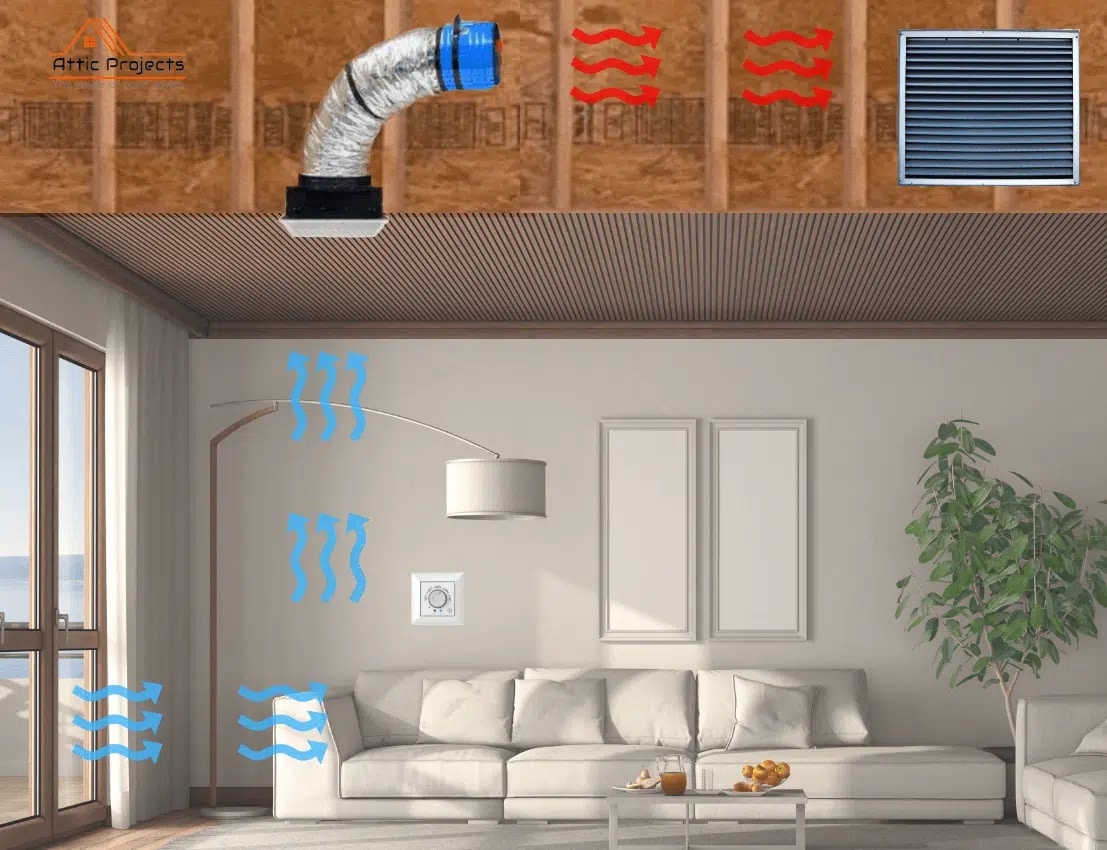If you have poor ventilation in your home, you may benefit from installing a whole-house fan. A whole-house fan can improve circulation and make your home more comfortable for you and your family. So today, Hoffman Brothers are here to answer the question: How does a whole-house fan work?
What Is a Whole-house Fan?
A whole-house fan, as the name implies, is a fan that circulates air throughout your entire home. Whole-house fans fit between your ceiling and pull air through the windows and out of the roof. The typical whole-house fan offers between 15 and 23 air changes per hour.
A whole-house fan differs from an air conditioning system in that it doesn’t use compressors or refrigerant fluid to cool air. It simply circulates air through the windows and out of the roof. Many homeowners buy a whole-house fan in addition to their air conditioner for maximum circulation.

Whole-house Fan – Dos and Don’ts
The following are some useful dos and don’ts to keep in mind when considering a whole-house fan. Paying attention to these tips could mean the difference between a successful project and a costly mistake.
Do’s
Ask your utility provider whether they offer energy rebates for high-efficiency home upgrades. You can take money directly off your tax bill with energy tax credits.
Base your purchase on the square footage of your house. Most whole-house fan manufacturers indicate how much square footage their fans can serve. If you cannot find an exact match, choose the next highest option.
Turn off the AC when your fan is in operation.
Keep the fan on during the morning and late afternoon for maximum effectiveness.
Open doors and windows when the fan is active to avoid backdrafts of carbon monoxide from your furnace and water heater.
Don’t…
Buy a fan without researching models, sizes, and power requirements. You need a fan that is the right size for your home to maximize energy efficiency and fan performance.
Buy a cheap fan to reduce expenses. Cheap whole-house fans are unreliable, loud, and not worth the installation hassle. Instead, purchase a high-end model that will last you several years.
Use the fireplace when the fan is on. Pressure differentials will cause it to vent incorrectly, making it difficult to regulate your home’s interior temperature.
How To Use a Whole-House Fan
You’re probably wondering now: How do I use a whole-house fan? Fortunately, fan operation is straightforward. Open at least half of the windows in your house and turn off the central AC. Once you flip on the fan, open the front door to allow air to circulate through the house and out of the attic.
You must remember to open your doors and windows, or the circulation will suffer. Additionally, leaving your central AC will waste the cool air your fan brings through the house.
Installation Process – Whole-House Fan
The installation process for a whole-house fan is complex and difficult for non-professionals to perform. The main difficulty is ensuring there is enough ventilation space for the size of the fan. The typical whole-house fan requires about one square foot of ventilation space for every 750 cupid feet per minute (CFM) fan capacity.
In addition to the fan, contractors will have to install new attic vents. These vents need to be large enough to handle the amount of air the fan expels. Fan vents typically have removable airtight vent covers so you can switch between central air conditioning and fan utilization to cool your house.
How Is a Whole-House Fan Different From an Attic Fan?
A whole-house fan is similar to an attic fan but fundamentally different in that it works for your entire house. Attic fans only operate in the attic, and you use them year-round. With a whole-house fan, you switch between it and your AC for different cooling periods. Most people use their whole-house fan only during the spring and summer.
Pros and Cons of Whole-House Fan
Whole-house fans come with several advantages and disadvantages.
Pros
You can save money on cooling costs by using the fan instead of traditional AC during the summer.
Whole-house fans circulate air and improve indoor air quality.
Whole-house fans require relatively little maintenance compared to other cooling methods and are coolant-free.
New models of whole-house fans are quiet.
Cons
Installation is tricky, especially when trying to get the right amount of ventilation space.
Running the fan without opening windows can cause backdrafts.
Fans are not that useful on very humid days.
Frequently Asked Questions (FAQs) – Whole-House Fans
Below are some of the most common questions about whole-house fans we receive.
How Much Does a Whole-house Fan Cost?
According to Home Advisor, it costs approximately $900 on average to install a whole-house fan, including the fan, motor, and necessary ductwork.
What Size of Whole-house Fan Do I Need?
The general formula for determining the necessary fan size is to calculate two to three CFM per square foot of your house. For example, if your home is 1,200 square feet, you should look for a fan with at least 2,400 CFM.
When Should I Use a Whole-house Fan?
Fans provide an alternative method of cooling that does not use as much electricity as a traditional AC. Most people use their whole-house fans during the spring and summer.
How Does a Whole-house Fan Work?
A whole-house fan works by pulling air through your open doors and window and out of a vent through the attic. Attics create negative pressure in your home to circulate air.
Does a Whole-house Fan Really Work?
Yes, whole-house fans cool your home and contribute to better air quality. A new fan works with traditional air conditioning to improve indoor comfort.
Contact Us Today!
Now that you know the answer to “How does a whole-house fan work?” it’s time to take the next step. Contact Attic Projects to schedule an appointment.



